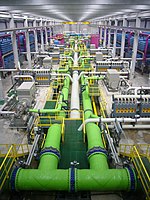
Photo from wikipedia
Seawater desalination plants provide an alternative solution to the problem of water scarcity although the process involved produces not only water, but also brine. The most practical and least expensive… Click to show full abstract
Seawater desalination plants provide an alternative solution to the problem of water scarcity although the process involved produces not only water, but also brine. The most practical and least expensive ways of disposing of the brine are to discharge it into the sea (41%) or sewers (31%). At the present time, there are no standards that specifically regulate the disposal of brine or the maximum concentration of sodium chloride, its main component and pollutant. Some countries such as Mexico and Chile have attempted to regulate some aspects of the desalination process; however, their draft laws do not include any indications regarding the discharge of salt residues or maximum permissible limits. This study analyzes the national legislative regimes in Chile and other countries that give rise to regulations governing the disposal of brine obtained from processes of desalination. It also proposes the establishment of a maximum limit for NaCl concentration, especially where brine is discharged into the sea or reused in sustainable energy processes.
Journal Title: Desalination and Water Treatment
Year Published: 2020
Link to full text (if available)
Share on Social Media: Sign Up to like & get
recommendations!